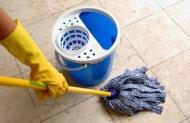Nottinghamshire Healthcare Trust has improved its standards of cleanliness and infection control in its inpatient units thanks to an audit tool called MICE, as staff from the trust explain

Nottinghamshire Healthcare Trust has seen year on year improvements to standards of cleanliness and infection control in its inpatient units thanks to an audit tool that was developed in-house to address the issues that historically contributed to less than acceptable standards.
The monitoring infection cleanliness and the environment (MICE) tool also aims to address some of the specific trust quality priorities that embrace safety, clinical effectiveness and the patient experience and organisational learning, where problems arise.
In 2004, the standards of cleanliness in some of the trust’s units were extremely poor, with some areas only showing results of 28 per cent. The National Standards of Cleanliness (core 49 elements) had just been published, but these were predominately acute focused. Some clinical staff did not accept responsibility for their environments and did not fully appreciate the value and the impact on patients’ wellbeing of achieving a positive result.
‘The key was to demonstrate to busy teams that this one overarching tool could drive up quality and reduce the number of audits’
The cleaning standards were poor; control of infection at that time was undertaken by an infection prevention and control lead and their auditing found results equally poor. Therefore, strong leadership was seen as a priority in addressing these poor standards, working collaboratively with the facilities department, infection, prevention and control nurses, matrons and care environment coordinators.
As part of a regular meeting, the infection control lead and the facilities manager (hotel services) reviewed audits they were currently undertaking and established that replication was taking place. They were also mindful that new regulations including the matron’s charter, PEAT, National Specification Cleanliness, Standards for Better Health, the Health Act and audit tools for monitoring would have implications for the organisation and responsibilities at a clinical level.
This was escalated to the head of facilities, who worked closely with the associate director of nursing to initiate a piece of work, which resulted in the MICE tool. This was seen as an effective solution to the problem of both multiple audits and the lack of applicable standards for mental health settings.
Clinical buy-in
It was clear that getting buy-in from clinicians was required to ensure the success of the tool as they had substantial numbers of audits already. The key was to demonstrate to busy teams that this one overarching tool could drive up quality and reduce the number of audits they undertake, which were affecting clinical resources, including time.
Funding was made available via the head of facilities to support the development of the tool and the additional training that would be required to ensure accuracy and consistency.
‘It was felt that matrons were in the key position to be able to objectively look at the areas and score appropriately’
A formal partnership was forged between facilities, matrons, infection prevention and control nurses and care environment coordinators who attended a workshop to learn the importance of cleanliness, for example how to clean a commode, and the direct impact that would have on the patient experience and reducing infections.
Following the first draft of the audit the associate director of nursing circulated the tool saying that it should take place on a monthly basis. The responsibility for that rested with the care environment coordinators and matrons as it was felt that they were in the key positions to be able to objectively look at the areas and score appropriately.
Action plans were then completed and the results tracked and evidenced on a master score sheet, which was placed on the matron shared drive and sent to governance teams and to the trust performance department on a quarterly basis. The results were presented to the infection control (local services) meeting for discussion.
Improved standards
Standards improved over six months but it became apparent from feedback from matrons and care environment coordinators that additional elements needed to be added to the audit tool to ensure elements were not being missed, for example cleaning of medical devices such as blood glucose monitoring machines.
‘The MICE tool has raised standards to above 90 per cent, previously not seen as achievable’
Clinical areas failing to achieve the required standards were jointly monitored by the infection prevention and control team and facilities manager to ascertain reasons for a drop in standards and monitored on a weekly basis until the standards improved.
This approach to the standards of cleanliness resulted in sustained improvement year on year. As the audit tool identifies areas that are failing and provides evidence to escalate early concerns, it has given the trust the ability to ensure resources are allocated for improvement to identified areas and has contributed to the positive standards of cleanliness and infection control within the service user environment.
A competitive culture has developed between areas participating in this audit programme. Peer audits form part of the programme and consequently support the learning of new leaders and sharing of good practice across the division and wider organisation.
Staff have welcomed the value and ease of using the MICE tool, which has raised standards to above 90 per cent; previously not seen as achievable within mental health services.
Helen Crompton is facilities manager, Annie Clarke is a ward manager and Sandra Crawford is associate director of nursing, quality and patient experience at Nottinghamshire Healthcare Trust



























No comments yet